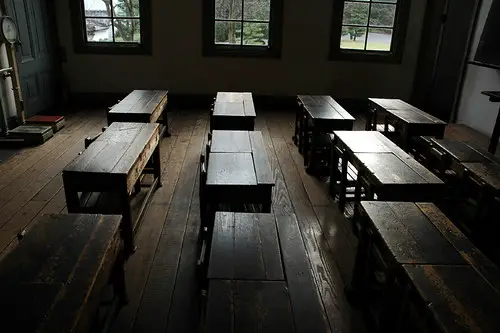It’s an age-old tug of war, financial resources on one end, the future of our children on the other. School underfunding is a pressing issue that not only sparks debates but also directly concerts the quality and equity of education.
Despite its critical consequences, the root causes of underfunding are multifaceted, challenging, and often deeply ingrained within our societal structures and policies.
In this deep dive, we unpack the various layers behind the underfunding of America’s schools, shedding light on the reasons why this challenge persists and examining what can be done to turn the tide.
The Landscape of School Funding Challenges
Every brushstroke in the picture of underfunded schools is as intricate and telling as the next. But before we delve into the finer details, it’s imperative to set the stage and understand the broad strokes that frame the issue.
In many communities, the amount of funding received by schools is directly proportional to the property taxes within their district.
This practice of funding education at the local level results in a patchwork system, where some schools enjoy ample resources while others are left to make do with less.
https://youtu.be/MBjrdHANZXo?si=n1i6BIpzK-2ONqoC
The very premise of this funding model creates stark disparities, laying the foundation for a two-tiered education system that echoes inequality.
Additionally, federal and state funding, which are designed to buffer these discrepancies, often fall short.
Bureaucratic red tape, legislative squabbles, or simply insufficient funding allocation perpetuate the crisis, leaving underprivileged schools with inadequate resources to meet the needs of their students.
Untangling the Factors Behind Underfunded Schools
Peeling back the layers of school underfunding reveals a complex web of factors that contribute to this systemic issue. Here, we shine a light on the primary culprits responsible for the chronic shortfall in educational investment.
-
A Tale of Unequal Tax Bases
The direct link between property taxes and school funding is a double-edged sword. While it aims to incentivize communities to invest in their local schools, it inherently disadvantages areas with lower property values.
The result is a cycle difficult to break: undervalued properties lead to reduced tax revenues, which in turn starve schools of essential funds, perpetuating a generational gap in educational access.
-
The Complicated Role of State and Federal Funding
The augmenting role of state and federal funding is critical. However, these additional resources are often not enough to bridge the gap.
Compounded by dramatic cuts during economic downturns, this piecemeal approach leaves schools vulnerable and unable to plan for their long-term educational requirements.
https://www.pastpapersinside.com/pros-and-cons-of-teaching-in-florida/
-
Administrative Leaks and Red Tape
Inefficiencies within funding structures create a siphon that drains resources away from where they are actually needed: the classroom.
From over-bloated administrative systems to the labyrinthine complexities of funding formulas, the actual amount reaching the frontline of education is often disappointingly modest.
Who Bears the Brunt of Underfunding?
The weight of underfunding is shouldered by the ones least able to bear it: our students and teachers. When dollars are scarce, the investments that create vibrant, engaging educational environments are often the first to go.
-
Students’ Plight: Dearth of Materials and Services
Classrooms bereft of textbooks, science labs without equipment, and outdated technology that cannot keep pace with a modern world; within underfunded schools, the list of deficits grows longer each year.
It’s not just about the material—lack of resources means fewer opportunities for experiences that expand students’ horizons and prepare them for a competitive future.
-
The Teacher Exodus: Attrition and Burnout
In many underfunded schools, there’s a silent but significant teacher crisis. Educators, already underpaid, work long hours with few resources, struggling to meet the diverse needs of their students.
The result is a high turnover rate, which proves disruptive to the continuity of education.
Those who stay find themselves battling not just apathy, but burnout, as the emotional and financial costs of their profession erode the very passion that drew them to teaching.
Pathways to Alleviating School Underfunding
The path to alleviating school underfunding is as nuanced as the problem itself. While there is no silver bullet, a tapestry of solutions can weave a future where all schools are adequately resourced to educate and inspire.
-
A Step Towards Fairness
Reformulating funding policies at both the state and federal levels to ensure that schools with the greatest need receive sufficient resources is a crucial first step. Implementing funding formulas that factor in not just the economic profile of a district but also the actual costs of education can help bridge the funding gap.
-
Consolidating and Simplifying Bureaucracy
By streamlining administrative processes and cutting through the red tape, more of the allocated funds can reach the intended recipients. This efficiency is not just about saving money; it’s about redirecting it to fulfill its purpose: the enrichment and advancement of education.
-
Building Public-Private Partnerships
Innovative partnerships between the private sector and public education can provide much-needed resources without overburdening taxpayers. Whether through corporate sponsorships, infrastructure investments, or curriculum development, such collaborations can inject new life—and funds—into our schools.
The Impact of Increased Funding on Education
The transformative power of increased funding is not just a theory—it’s a reality illustrated by numerous success stories. When schools are adequately funded, the opportunities for a high-quality education multiply, and the potential for students to excel becomes not just a dream, but an achievable goal.
-
A District Turnaround
Examining the before-and-after of a district that received a boost in funding can be profoundly inspiring. Stories of renewed student engagement, higher graduation rates, and a burgeoning college enrollment exemplify the far-reaching impact that adequate resources can catalyze.
-
A Showcase of Educational Enhancement
Increased funding doesn’t just elevate the school that receives it; it has ripple effects that strengthen communities and the nation. By fostering the growth of a generation with expanded knowledge and skills, educational investment becomes an engine of economic and social progress.
Why We Can’t Afford Underfunded Schools?
As we close the chapter on our exploration of school underfunding, the verdict is clear: the cost is too high. We cannot afford to underinvest in education, which is the foundation upon which our society and economy are built.
It is the veritable fountainhead of progress, the beacon that lights the future for generations to come.
Conclusion:
Understanding the intricacies of school underfunding is just the beginning. It is up to us, as a society vested in the betterment of our children and the strengthening of our communities, to turn this knowledge into purposeful action.
Our schools need champions—individuals, organizations, and policymakers willing to wield their influence and resources to ensure that every child has access to a well-funded education.
The journey toward fully funded schools will be arduous, fraught with obstacles and setbacks. However, with a collective will that matches the importance of the task at hand, we can rewrite the narrative.
Let’s choose to invest in our schools, our children, and our collective future. The stories of transformation and progress are waiting to be written, anchored in the joy of learning and the fulfillment of potential that knows no bounds.



